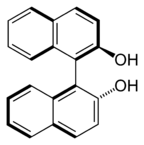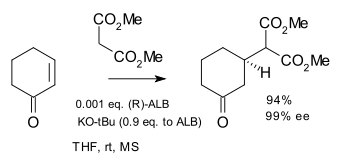1,1'-Bi-2-naphthol
| |||
| |||
| Names | |||
|---|---|---|---|
| IUPAC name
[1,1'-binaphthalene]-2,2'-diol | |||
| Other names
1,1'-bi-2-naphthol 1,1-binaphthol BINOL | |||
| Identifiers | |||
| |||
| 3D model (JSmol) |
|||
| ChemSpider | |||
| ECHA InfoCard | 100.009.104 | ||
| PubChem CID |
|||
| |||
| |||
| Properties | |||
| C20H14O2 | |||
| Molar mass | 286.32 g/mol | ||
| Melting point | 205 to 211 °C (401 to 412 °F; 478 to 484 K)[1] | ||
| Except where otherwise noted, data are given for materials in their standard state (at 25 °C [77 °F], 100 kPa). | |||
| | |||
| Infobox references | |||
1,1'-Bi-2-naphthol (BINOL) is an organic compound that is often used as a ligand for transition-metal catalysed asymmetric synthesis. BINOL has axial chirality and the two enantiomers can be readily separated and are stable toward racemisation. The specific rotation of the two enantiomers is +/- 35.5° (c=1 in THF). BINOL is a precursor for another chiral ligand called BINAP.
Preparation
The organic synthesis of BINOL is not a challenge as such but the preparation of the individual enantiomers is.
(S)-BINOL can be prepared directly from an asymmetric oxidative coupling of 2-naphthol with copper(II) chloride. The chiral ligand in this reaction is (S)-(+)-amphetamine.[2]

Racemic BINOL can also be produced using iron(III) chloride as an oxidant. The mechanism involves complexation of iron(III) into the hydroxyl, followed by a radical coupling reaction of the naphthol rings initiated by iron(III) reducing into iron(II).
Optically active BINOL can also be obtained from racemic BINOL by optical resolution. In one method, the alkaloid N-benzylcinchonidinium chloride form a crystalline inclusion compound. The inclusion compound of the S-enantiomer is soluble in acetonitrile but that of the R-enantiomer is not.[3]
In another method BINOL reacts with the acid chloride pentanoyl chloride to obtain the di-ester compound. The enzyme cholesterol esterase is then added in the form of bovine pancreas acetone powder which is able to hydrolyse the (S)-di-ester but not the (R)-di-ester.[3] The (R)-dipentanoate is hydrolysed in a second step with sodium methoxide.[4]
Third method employs HPLC with chiral stationary phases.[5]
BINOL compounds
Many variations of BINOL exist, BINAP being one of them.
The compound AlLibis(binaphthoxide) (ALB) is prepared by reaction of BINOL with lithium aluminium hydride.[6]
It has been employed in an asymmetric Michael reaction with cyclohexenone and dimethyl malonate:
See also
References
- ↑ Datasheet, chemexper.com
- ↑ Brussee, J.; Jansen, A. C. A. (1983). "A highly stereoselective synthesis of s(−)-[1,1′-binaphthalene]-2,2′-diol". Tetrahedron Letters. 24 (31): 3261–3262. doi:10.1016/S0040-4039(00)88151-4.
- 1 2 "RESOLUTION OF 1,1'-BI-2-NAPHTHOL", Dongwei Cai, David L. Hughes, Thomas R. Verhoeven, and Paul J. Reider, in Organic Syntheses Coll. Vol. 10, p.93; Vol. 76, p.1
- ↑ "(S)-(−)- AND (R)-(+)-1,1'-BI-2-NAPHTHOL", Romas J. Kazlauskas in Organic Syntheses, Coll. Vol. 9, p.77; Vol. 70, p.60
- ↑ Landek, G.; Vinković, M.; Kontrec, D.; Vinković, V. (2006). "Influence of mobile phase and temperature on separation of 1,1 '-binaphthyl-2,2 '-diol enantiomers with brush type chiral stationary phases derived from L-leucine". Chromatographia. 64 (7-8): 469–473. doi:10.1365/s10337-006-0041-5.
- ↑ A practical large-scale synthesis of enantiomerically pure 3-[bis(methoxycarbonyl)methyl]cyclohexanone via catalytic asymmetric Michael reaction Tetrahedron, Volume 58, Issue 13, 25 March 2002, Pages 2585–2588 Youjun Xu, Ken Ohori, Takashi Ohshima, Masakatsu Shibasaki doi:10.1016/S0040-4020(02)00141-2




.svg.png)
